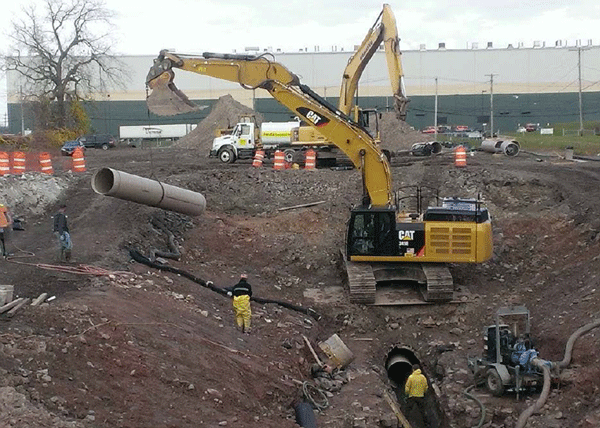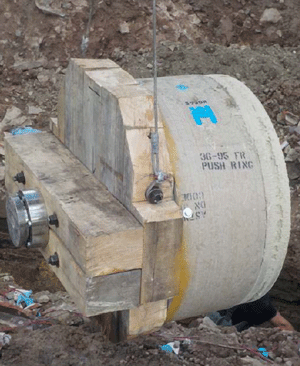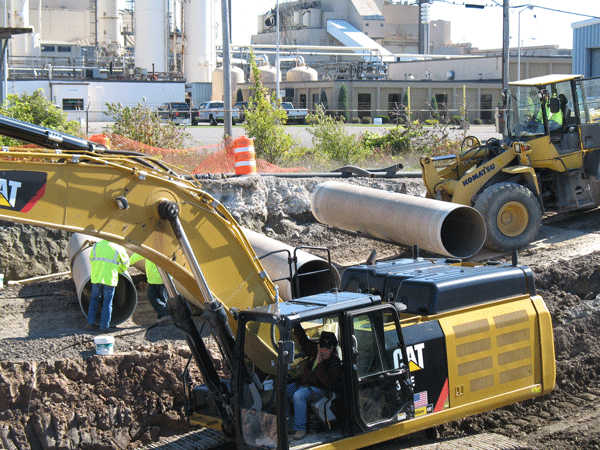The Niagara Falls Water Board (NFWB) (Niagara Falls, New York) had long been aware of a problem involving the corrosion of sewer lines by groundwater at its Iroquois Street sewer. But upon learning in 2013 that the sewer had serious structural issues as well, the board’s need for a solution became urgent.
“What was first thought to be an infiltration problem evolved to include serious sewer structural and longevity concerns,” says John Goeddertz, a senior project manager at engineering consultancy AECOM.
The NFWB provides water and sewer services within Niagara Falls, New York, and adjoining areas. In all, it serves approximately 50,000 people through more than 16,000 accounts. The board aims to become a first-class competitive utility in the next five to seven years, and its strategy to get there includes continually investing in infrastructure to maintain its facilities.
This, in turn, spurred the Iroquois Street Sewer Lining Project—a 2,200-ft (670-m) line running from Buffalo Avenue to the Southside Interceptor in Niagara Falls.
History
The original Iroquois Street sewer was built in 1917, and segmented block was utilized to construct a 54-in (1.4-m) diameter sewer. Segmental block pipe came into use in the early 1900s, and it was the tool of choice until the 1930s, when precast pipe became more readily available.
In the late 1980s, however, NFWB began a series of projects aimed at reducing significant groundwater infiltration present in the Iroquois Street area. The projects included downstage and chemical grouting, internal and external pipe seals, and flow rerouting. In the early 2010s, sewer flows were again rerouted to abandon and seal off the most heavily damaged and leaking section of the sewers.
Investigation Finds New Solutions
Those repairs on the sewers and tunnels provided some benefits, the NFWB says. However, after estimates pegged the groundwater infiltration at about 5 million gal (18.9 million L), the board launched an investigation in early 2013 into the problems and an evaluation of corrective alternatives.
After completing the investigation, the board determined that a 36-in (0.9-m) inside diameter liner pipe was most suitable for conveying the anticipated sewage flow. However, the unique nature of the surrounding area presented several complicating factors.

“Due to the depth of the sewer and the presence of underground utilities associated with both a nearby chemical plant and an electrical substation, a minimal amount of excavation [Figure 1] was preferable,” says Goeddertz.
“The industrial nature of the surrounding land and interfering utilities favored a sliplining approach for sewer rehabilitation,” he adds. “The specifications were written around sliplining the sewer and connecting tunnel with a small variety of acceptable liners.”
Heading into the project, the NFWB determined that sliplining with the 36-in (0.9-m) liner pipe was necessary to restore structural integrity. The liner pipe would be inserted from one push pit, thus minimizing the potential for uncovering contaminated soils.
Material Choices
The construction work was awarded to Yarussi Construction (Niagara Falls, New York), and contract documents allowed the use of three different pipe materials. Options included fusion-welded high-density polyethylene (HDPE) pipe; fusion-welded polyvinyl chloride (PVC) pipe; or a relatively new liner pipe system.
In the Iroquois Street project, the contractor chose centrifugally cast, glass-fiber-reinforced, polymer-mortar pipes manufactured by Hobas Pipe USA (Houston, Texas) for the installation because the gasket-sealed pipe could withstand the potential compressive forces needed to push 1,500 ft (457-m) of pipe from a single push pit. The pipe is strong and light with consistent dimensions, smooth surfaces, high stiffness, and a designed service life of up to 100 years.
“The overall cost of using [liner pipe] with the segmental joints was less expensive as a total installed cost,” says Camil Pachucki, estimator and project manager at Yarussi Construction.
As part of the sewer cleaning operation, intermediate manholes were excavated and a mandrel was pulled to prepare for liner insertion. The liner pipe was then shipped to Niagara Falls via truck within a week’s time in September 2015.
 Once the host pipe was prepared, Yarussi sliplined 80% of the length in three days from the push pit, inserting liner pipe in both directions. There were two separate lining operations, with one proceeding southward from the pit and the other proceeding northward. The southward operation pushed about 900 ft (274 m) of pipe, while about 300 feet (91 m) were installed to the north.
Once the host pipe was prepared, Yarussi sliplined 80% of the length in three days from the push pit, inserting liner pipe in both directions. There were two separate lining operations, with one proceeding southward from the pit and the other proceeding northward. The southward operation pushed about 900 ft (274 m) of pipe, while about 300 feet (91 m) were installed to the north.
In all, 1,175 ft (358-m) of the segmented block sewer was cleaned and lined. The stretch was completed by open cut methods into the rock tunnel section.
“We were able to easily install all the sliplining pipe from one pit,” says Pachucki. “And as a requirement of the specifications, we used a load cell on the push frame [Figure 2], and it recorded the load on the pipe. We pushed the pipe in with flow, and it slid in very well.”
The recorded loads increased consistently as subsequent segmental pipes were added to the line. The maximum load was about 10,000 lb (4,536 kg) on the northward run, and about 21,000 lb (9,525 kg) on the southward section. The calculated friction factors were very typical for sliplining installations, says Rene Garcia, an engineering supervisor with Hobas.
Results
Since the project was completed less than a year ago, the NFWB continues to monitor the area to determine the ultimate success of the revamp, and they are encouraged by the early signs.
“The principal goal of the project was to reduce inflow and infiltration, and the results have been promising,” says Richard Roll, technical services director for the NFWB.

Specifically, Roll says the project has led to reduced chemical usage and pumping costs at the nearby treatment plant (Figure 3), while also reducing wet-weather combined sewer overflow.
“An old sewer in the process of failing has been replaced with one expected to provide many decades of reliable service,” Roll says.